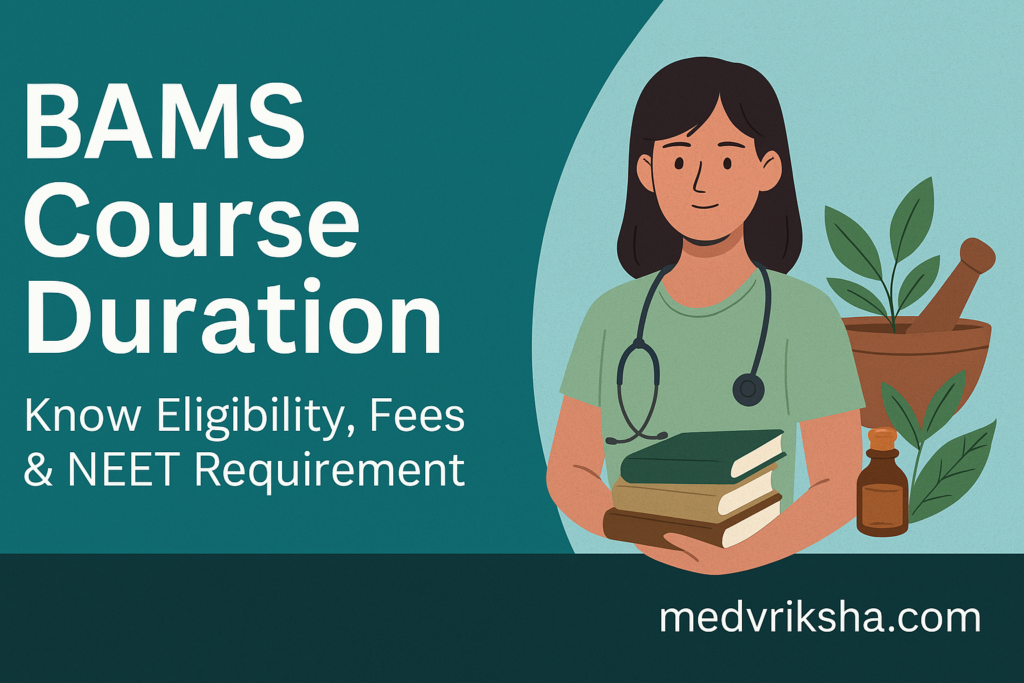Modern society recognizes Ayurveda as the traditional Indian medical system which continues to gain popularity both nationally and internationally. People increasingly select natural healing practices which has boosted the need for Ayurvedic doctors. A career in Ayurvedic medicine can become accessible through the BAMS course eligibility for anyone interested in this time-tested practice
In this blog, we’ll break down everything you need to know about the BAMS course duration, structure, eligibility, fees, and much more—so you can decide if this path is the right one for you

What is BAMS?
BAMS (Bachelor of Ayurvedic Medicine and Surgery) integrates modern medicine education with Ayurvedic education for undergraduate students. Students learn complete Ayurvedic principles while they also gain knowledge about basic modern medical concepts through this program
Through the coursework graduates become capable of using Ayurvedic method along with herbal medication and lifestyle modifications to identify illness and give treatment while preventing various ailments. Graduates may work directly as Ayurvedic doctors but also possess the option to specialize or conduct research in their field
BAMS Course Duration in India
The BAMS course duration in India is typically 5.5 years, which includes
- 4.5 years of academic study
- year of compulsory rotatory internship
The academic curriculum is divided into three professional phases, each lasting 1.5 years
1. First Professional (1.5 years)
- Sanskrit
- Basic Principles of Ayurveda
- Physiology (Kriya Sharir)
- Anatomy (Rachana Sharir)
2. Second Professional (1.5 years)
- Dravyaguna (Ayurvedic Pharmacology)
- Rasashastra (Ayurvedic Pharmaceutics)
- Pathology (Rog Nidana)
- Toxicology (Agad Tantra)
3. Third Professional (1.5 years)
- General Medicine (Kayachikitsa)
- Panchakarma
- Surgery (Shalya Tantra)
- Obstetrics and Gynecology (Prasuti Tantra & Stri Roga)
4. Internship (1 year)
- Kayachikitsa
- Shalya Tantra
- Shalakya Tantra (ENT)
- Panchakarma
- Emergency management
During this year, students gain hands-on experience under supervision, preparing them for real-world clinical practice
BAMS Course Eligibility
To enroll in the BAMS course eligibility program, students must fulfill the following criteria
- Must have completed 10+2 with Physics, Chemistry, and Biology as main subjects.
- Minimum 50% aggregate marks in 12th standard (some colleges may require more).
- Candidates must be at least 17 years old at the time of admission.
- NEET qualification is mandatory for admission in BAMS courses across India
Is NEET Required for BAMS?
Yes. BAMS need Neet program admission requires exam qualification set by the Ministry of AYUSH through CCIM regulations for all Indian AYUSH government and private educational institutions
BAMS Course Duration and Fees
The BAMS course fees vary depending on the institution and whether it is a government or private college.
Government Colleges
- Fees range between ₹20,000 – ₹80,000 per year
Private Colleges
- Fees can range between ₹1.5 lakh – ₹3 lakh per year
So, the total BAMS course duration and fees for the entire 5.5-year program can range from ₹1 lakh (in government colleges) to over ₹15 lakh (in private colleges).Your NEET score determines your ranking and helps you get placed in a reputed Ayurvedic medical college.
Scope After BAMS
After completing BAMS, students have several career options
Clinical Practice
You can start your own Ayurvedic clinic or work with established healthcare centers.
Higher Education
Many pursue post-graduate courses like:
- MD (Ayurveda)
- MBA in Healthcare Management
Government Jobs
Opportunities in government hospitals, research centers, and AYUSH departments.
Research and Academia
Work as research scholars or faculty in Ayurvedic colleges.
Ayurveda Product Development
Join Ayurvedic medicine companies for R&D and product formulation.
Why Choose BAMS?
Here are some reasons students opt for BAMS:
- Deep-rooted in Indian tradition and natural healing
- Increasing global demand for alternative medicine
- Rising job opportunities in India and abroad
- Flexibility to start your own practice
Top Ayurvedic Colleges in India (No Institute Promotion)
This article does not mention particular schools but indicates that top Ayurvedic colleges are partnered with respected universities and hold CCIM recognition. Admission is strictly through NEET
For a reliable list of colleges, visit https://medvriksha.com.
Tips Before Choosing a BAMS College
- Check college recognition and affiliation
- Look at the faculty and infrastructure
- Find internship and hospital tie-up details
- Compare fees and hostel facilities
For more guidance on choosing the right path in Ayurveda, visit https://medvriksha.com — a trusted platform for Ayurvedic course information
FAQs – BAMS Course Duration and More
1. What is the total duration of BAMS?
A five-and-a-half-year course program for BAMS students requires one year of practical training
2. Is NEET compulsory for BAMS?
It is necessary to pass NEET for gaining admission to BAMS through the students can enroll at private institutions and government institutions
3. What is the average BAMS course fee?
Government institutions charge between ₹20,000 to ₹80,000 annually and private institutions charge between ₹1.5–3 lakh annually
4. Can I practice as a doctor after BAMS?
The practice of Ayurvedic medicine becomes accessible after completing state medical board registration
5. Which subjects are covered in BAMS?
The educational program at the medical college consists of Ayurvedic Medicine, Surgery, Pharmacology, Panchakarma, Gynecology and additional subjects
6. What is the scope of BAMS abroad?
Ayurvedic doctors find high market demand throughout the world where they deliver services in wellness tourism companies and herbal medical centers while providing alternative therapy
Conclusion
The BAMS course offers a deep and fulfilling career path for students passionate about natural healing, holistic medicine, and the science of life. With the right education and mindset, you can become a part of India’s rich Ayurvedic tradition and bring health and wellness to people around the world.
Whether you’re curious about the course structure, eligibility, or fees, we hope this blog gave you clarity and confidence to step forward.
